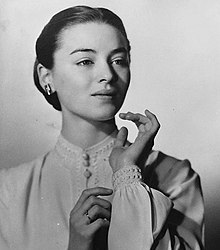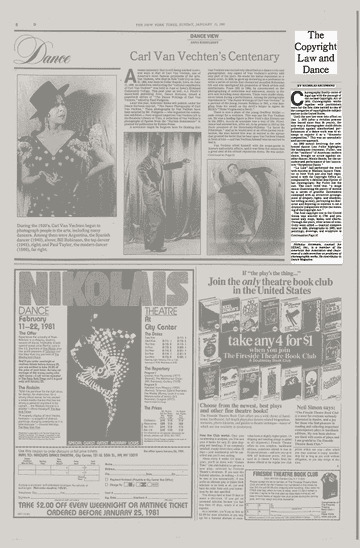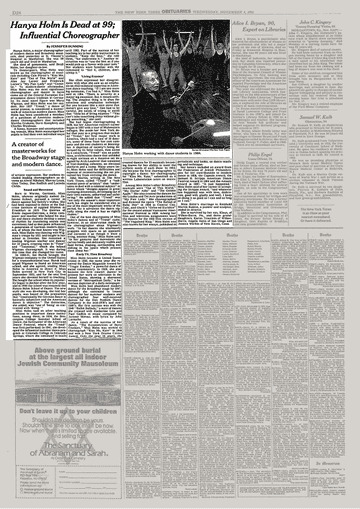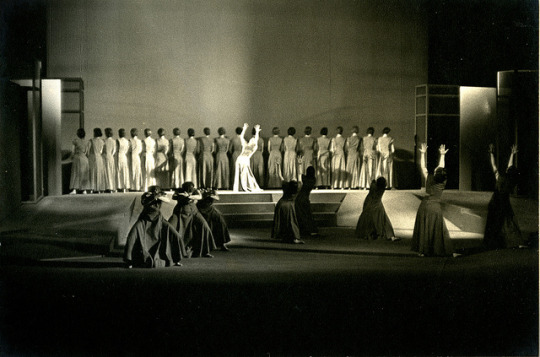Text
Holm Appreciation

Hanya Holm was a dancer, a choreographer, and an incredible dance educator. She is known as one of the “Big Four” modern dance influencers and in my eyes has earned that title. As a young woman, Hanya came by herself to the US with the intentions of teaching Wigmans style but ended up leaving a legacy of her own behind.
Her approach to teaching dance gave dancers the freedom and liberation they needed during hard times throughout history. Hanya’s main goal through dance education was to help each dancer express their inner personality. She would try to find the essence of dance and understand where the movement came from within the body so that it was a natural response in the body of the dancer.

Overall, I think that Hanya’s techniques on dance education changed the way dance was overall seen and conveyed. I think that giving the individual dancers the freedom to express their own form of individuality was something very new to concert dance as art. This expression and liberation allowed for the appearance of individual character making each piece unique to the performer.
1 note
·
View note
Text
Finding A Place For Hanya Holm
By Claudia Glitelman

Below I have attached an article by Claudia Glitelman that talks about how Hanya Holm became one of the four founders of American modern dance. Often Holm is compared to Graham, Humphry, and de Mille but in her article, Gitelman explains why that shouldn’t be the case. As Glitelman states, “Although those three were also rebels and groundbreaker, they worked within the security of American pedigrees and understood instinctively the syntax and grammar of their society.” Throughout the article, she reflects on how Holm had been a young immigrant all alone striving to make a difference within the American dance culture.
https://www.jstor.org/stable/1568013?seq=21#page_thumbnails_tab_contents
1 note
·
View note
Text
Holm’s Technique and Choreography
Holm’s technique stressed the importance of pulse, planes, floor patterns, aerial design, direction, and spatial dimensions. Her movement emphasized the freedom and flowing quality of the torso. Holm’s trained through improvisation and focused her teaching through learning by discovery. Choreographically her movement focused on the body's relation to space and emotion, which was an extension of Wigman and Rudolf Laban. She worked on movement that projected into space. Holm's stylistic idea was about "absolute dance" without pantomime or dramatic overtones. Attention to conveying an idea in her choreography was more important than the dancers' technical ability. Holm would say, "I want to see a sign of passion. I want to see the raw if struggling to express itself. A work must have blood."

Holm’s technique helped dancers find freedom in expression. I think that Holm truly helped many of her students find their own style and ultimately liberation. After researching Holm’s style, I decided to look to video accounts on Holm’s teaching and technique from some of her students themselves. Personally, I feel that Holm was one of the first teachers to help dancers express individuality and to really try and help them find themselves. I think that knowing your own style and what makes your specific movements unique was and is very important in dance. Holm gave her students a place to relax and a place to freely express themselves, giving them refuge from the chaotic world around them.
youtube
https://wesscholar.wesleyan.edu/wespress_dance/6/
https://www.jstor.org/stable/1568013?seq=10#metadata_info_tab_contents
0 notes
Text
The First to Copyright Choregraphy
The 1976 Copyright Act was the first U.S. law expressly to make choreography a copyrightable subject matter. Holm, who had always strongly believed in Labanotation, asked Ann Hutchinson to notate the dances during the rehearsals of Kiss Me, Kate. In 1952, Hanya Holm registered the choreography for the Broadway musical Kiss Me Kate as the first claim to copyright on a choreographic work. The entire script was photographed on microfilm and is now on file at the Library of Congress.
Holm had to register the choreography as a drama, rather than choreography. Holm is now on record as a contributor to the revised law. In 1960 she was invited to comment on the Copyright Law Revision Study number 28 written by attorney-advisor Borge Varmer. Holms letter from January 2, 1960, made three points: choreography should be subject to copyright, choreography should be named as a separate category of copyrightable matter, and the term ‘choreographic works” should include dramatic concert dance pieces: Lyric-dramatic concert pieces. Satirical concert pieces, and dance in operas, musical comedies, and revues.

Personally, I think that Holm’s actions played a vital role in both dance itself and dance history. As Sorell states in his book listed below, “It has given a certain official approval to dance notation and put it on a similar level with music notation. This act also gave the choreographer the possibility to be recognized as the owner of their own work, and it established a choreographic composition as an entity apart from any specific performance of it.”
This one act caused a ripple effect within the dance community. I think that this invoked a sense of ownership within artists and almost a form of validation through authentication within the art community. Dance went from something that was intangible to something that could be tangible. I think that the world would be so different today if the only type of dance that could be copyrighted must be a drama. Those restraints on dance kept other amazing works, styles, and artists in the dark. Personally, I am very thankful for the copyright act Holm helped place on choreography because without it dance may not have been where it is at today.

https://wesscholar.wesleyan.edu/wespress_dance/6/
https://www.nytimes.com/1981/01/11/arts/the-copyright-law-and-dance.html
https://www.copyright.gov/history/lore/pdfs/201502%20CLore_February2015.pdf
0 notes
Text
Trend
During the time in which the Wigman School in New York changed its name, to Hanya Holm Studio, fascism was on the rise. During this same year, 1936, Hanya Holm became a US citizen in 1939. Holm’s most well-known piece Trend (1937) was a large-scale dance of social protest. Trend was the first modern dance to have prerecorded sound. This performance dealt with social criticism incorporating Austruktanz and American dance all in one! As John Martin in the New York Times called it "a colossal theme … Miss Holm opens up a new vista for the production of great dance dramas."

Holm is known for her expressive and emotional capabilities and style, her use of the two allowed her to convey dancers interpersonal feelings and thoughts. As a teacher, Holm encouraged her students to find their own individual ways of artistic expression. The new style she was developing, she told her students, was based on the proposition that "emotionally the German dance is basically subjective and the American dance is objective." The distinction, she added, was "one of 'being' as contrasted with 'doing.' " This quote goes to show that during this time, there began a change in the way dancers could express their interpersonal emotions and develop/express their own individuality.

Personally, I think that Holms style gave dancers a form of freedom when the US citizens needed it the most. When Holm combined the Austruktanz style of dance and American dance she drew out the freedom of expression in Americans. At the beginning of Holms time in America, the US was in the Great Depression, a time of high emotion and struggle. Following this depression, the US entered WWII, and Holm’s style provided individuals the feeling of freedom of expression.
https://biography.yourdictionary.com/hanya-holm
http://archives.nypl.org/dan/19791
0 notes
Text
Who was Hanya Holm?
Holm is recognized as one of the four early pioneers of modern dance in the United States, as well as one of the 20th century’s most sought-after choreographers of musical theatre. Holm was born March 3, 1893 in Worms-am-Rhine, Germany.

Holm’s early education took place at the Konvent der Englischen Fraulein in Mainz, followed by musical studies at the Hoch Conservatory and the Dalcroze Institute at Frankfurt-am-Main. She graduated in 1916 from the Dalcroze Institute at Hellerau and later taught Dalcroze and music until 1921. During this time Germany was recovering from World War I, however, it was a time of great artistic activity in Germany.
As a child, she fell in love with the dancing of Anna Pavlova, but Holm’s father disapproved of dance. Later in life, after she had been married and divorced, Holm knew she wished to dance professionally. After seeing Mary Wigman dance in 1921 Holm enrolled and was affiliated with the Wigman Central Institute form 1921-1931. Holm became a chief instructor in 1924 and director in 1929. Wigman’s responsiveness to the personality of each class, and the comprehensiveness of her curriculum became an enduring pedagogical model for Holm. Holm was an original member of the Wigman Concert Dance Group from 1923-1928.
In 1931, Holm was brought to the United States by Sol Hurok to open and direct a branch of the Wigman School in New York. Here Holm was the official representative of Mary Wigman in America and was often sought after by many. The presentations in which she regularly taught in Washington and Philadelphia, provided demonstrations to educational institutes and art organizations all over the country. During her first year in the United States enrollment was high but by 1936 anti-Nazi the feeling was strong in the United States, leading to the removal of Wigman’s name.

With Wigman’s approval, the school became the Hanya Holm studio in 1936. Following the change in name, Holm’s movement theories began to diverge from her teacher’s. Holm adapted the Wigman technique for her Americans students by bringing new energy and discipline to American modern dance. Holm’s training changed the way American dancers used space.
In 1934 Holm along with Martha Graham, Doris Humphrey and Charles Weidman founded the now famous Bennington School of dance. She taught in the summer until 1940, while also teaching at University of Iowa and in Colorado at the Perry Mansfield summer camp. During her time in Colorado, she found herself drawn to the landscape, and in the summer of 1941, she founded the Colorado College Summer School of the Dance. The school later closed in 1983.
Holm’s prolific output in the fields of musical theatre, opera, film, and television is said to have begun with Eccentricities of Davey Crockett. This piece was created for the cooperative Ballet Ballads in 1948. That same year, Holm collaborated with Jose Ferrer on The Insect Comedy, and by the end of the year, Cole Porter’s Kiss me Kate was in previews with Holm’s choreography. Over this span of time, Holm was the choreographer of over twenty theatrical productions.
http://archives.nypl.org/dan/19791
https://www.dance-teacher.com/ask-the-experts-do-you-prefer-apple-products-or-google-for-class-2631075711.html
https://books.google.com/books?id=tXwmCwAAQBAJ&pg=PA96&lpg=PA96&dq=pavlova+and+hanya+holm&source=bl&ots=WDANbKnji3&sig=ACfU3U16W4Op7LswkWqW7JNhIl5_-8cw6Q&hl=en&sa=X&ved=2ahUKEwiXxba1p93hAhVKHqwKHdhVDY4Q6AEwDXoECAcQAQ#v=onepage&q=pavlova%20and%20hanya%20holm&f=false
1 note
·
View note